A Look at Kimberly Morris's work in Comparison to the article: The environmental Injustice of Beauty: Framing Chemical Exposures From Beauty Products As a Health Disparities Concern by Ami R. Zota, ScD, MS; Bhavna Shamasunder, PhD, MES + An Interview with Kimberly Morris (Kimberly Morris, Bound, Digital Photo 40" x 60" 2018)
The environmental injustice of beauty: framing chemical exposures from beauty products as a health disparities concern
Ami R. Zota, ScD, MS; Bhavna Shamasunder, PhD, MES
The American Congress of Obstetrics and Gynecology(ACOG) committee opinion1 emphasizes that toxic environmental chemicals are a threat to human reproduction and that there may be differential vulnerability by life stage or social position. More recently, doctors around the world echoed these concerns through the International Federation for Obstetrics and Gynecology (FIGO) committee opinion. FIGO recommended that reproductive health professionals recognize disproportionate burdens to toxic chemical exposures in certain patient populations and champion policies that secure environmental justice.2 Environmental justice integrates concepts of environmental racism and inequality and is defined as the unequal distribution of environmental benefits and pollution burdens based on race.3 An understanding of how both social and environmental factors jointly may influence health is necessary for the elimination of health disparities.4 The Environmental Protection Agency definition,adopted by FIGO, elaborates on this principle for regulatory purposes and defines environmental justice as “the fair treatment and meaningful involvement of all people regardless of race, color, national origin, or income.” 2,5
Beauty product use is an understudied source of environmental chemical exposures and may be 1 avenue for health professionals to intervene among vulnerable populations such as women of color. Consumer products, and personal care products specifically, are a source of exposure to toxic chemicals for all women.6-8 Beauty products (1 category of personal care products) have limited and inconsistent disclosure of chemical ingredients, and most lack adequate data on health and safety.6,9
From the Department of Environmental and Occupational Health, George Washington University Milken Institute School of Pulic Health,Washington DC (Dr Zota); and the Urban and Environmental Policy Department, Occidental College, Los Angeles, CA (Dr Shamasunder). Received May 6, 2017; revised July 7, 2017; accepted July 15, 2017. Supported by a grant from the Passport Foundation and the National Institute of Environmental Health Sciences (NIEHS: R00ES019881) and faculty research support from Occidental College. The content is solely the responsibility of the authors and does not necessarily represent the official views of any of the funding agencies. The authors report no conflict of interest. Corresponding author: Ami R. Zota, ScD, MS. azota@gwu.edu 0002-9378 ª 2017 The Authors. Published by Elsevier Inc. This is an open access article under the CC BY-NC-ND license (http://creativecommons.org/ icenses/by-nc-nd/4.0/). http://dx.doi.org/10.1016/j.ajog.2017.07.020
Racial/ethnic differences in beauty product use are documented across multiple categories including skin care, haircare, and feminine hygiene (Table). However, evidence points to the limits of the examination of these exposures in isolation. Rather, we argue that health practitioners should consider an “environmental injustice of beauty” approach that incorporates the social factors that influence beauty product use and the potential for cumulative impacts that may arise because of co-occurring environmental exposures. This approach provides a more comprehensive picture of how environmental factors may shape reproductive health disparities.
Preexisting vulnerabilities and cumulative impacts
Beauty products contain multiple chemicals, such as formaldehyde, phthalates, parabens, lead, mercury, triclosan, and benzophenone, that can adversely impact health.6,9,10 Exposure to 1 of these chemicals has been linked to endocrine disruption, cancer, reproductive harm, and impaired neurodevelopment in children.11-14 Women 18e34 years old are more likely to be “heavy buyers” who purchase >10 types of products per year.15 These women and their offspring may experience heightened vulnerability to toxic environmental chemicals if products are used during sensitive periods of development such as preconception or pregnancy.2 Low-income and racial/ethnic minority groups may be further susceptible because they are exposed more frequently to multiple environmental and social risk factors and face poorer health outcomes.16 Nationally representative data of US reproductive-aged women suggest that women of color have higher levels of certain endocrine disrupting chemicals, such as phthalates and parabens, in their bodies compared with white women and that these racial/ethnic differences are not explained by socioeconomic status.17-20 Workers in the beauty industry, who are predominantly women of color and immigrant women, can also face occupational health hazards from chemicals in professional cosmetic products and ad-hoc workplace safety standards.21-23 Cumulative assessments of environmental risk factors among socially marginalized groups historically have prioritized place-based pollution sources, such as polluting industries or high traffic density24,25; however, beauty product exposures may be elevated in some of the same communities that encounter disproportionate exposures to place-based pollution.26,27
Social and economic dimensions of product use
The beauty product industry is estimated at $400 billion globally.28 According to market analyses and consumer profiles, multicultural beauty products have outpaced the overall cosmetics market.29 A African American consumers purchase 9 times more ethnic hair and beauty products than other groups30,31 and disproportionately purchase hair relaxers and straighteners. Latinos are the fastest growing ethnic beauty market segment,32 and Asian Americans spend 70% more than the national average on skin care products.33
Mass distribution of images that idealize whiteness can influence sales of hair straighteners, skin lighteners, and odor masking products.34,35 Racial discrimination based on European beauty norms can lead to internalized racism, body shame, and skin tone dissatisfaction, factors that can influence product use to achieve straighter hair or lighter skin. Thus, beauty product use may be 1 way that structural discrimination becomes biologically embedded.36,37
Targeted racial/ethnic marketing can influence product use and related health inequities by taking advantage of mainstream beauty norms.38,39 In a well-described example of the influences of marketing practices on health disparities, highly targeted menthol cigarette marketing in low-income inner city African American neighborhoods 38,39 created a racialized geography of tobacco-related health disparities.40 Targeted marketing of beauty products may similarly influence reproductive health disparities. We document evidence of demographic differences in product use and chemical exposures in the beauty industry. We then describe how external factors, such as targeted advertising, can influence product use.
Skin-lightening face creams
Women in Africa, India, the Middle East, Southeast Asia, and the Americas regularly use skin-lightening cosmetics.41,42 Skin-lightening creams can contain hydroquinone, topical corticosteroids, or inorganic mercury.43 Multiple cases of mercury poisoning, which is characterized by damage to the kidneys and the central nervous system, have been reported after use of skin-lightening products.44 The US Food and Drug Administration set a maximum allowable level of 1 ppm of mercury in skin products.45 However, skin products with mercury continue to be unregulated and available outside of the United States, and these products are still used by certain populations in the United States, including Dominican and Mexican American women.45-47 In a population-based study of New York City residents, those with the highest urine mercury levels were foreign-born Dominican women of reproductive age, and skin-lightening creams were identified as a source of exposure among highly exposed populations.45 Similarly, a medical case study reported that a pregnant Mexican
American woman’s elevated blood mercury level of 15 mg/L (nearly 3 times the Centers for Disease Control and Prevention early reporting threshold) was linked to face creams that contained >20,000 ppm of mercury.46
Skin-lightening creams are sold globally, marketed to darker skinned women. Scholars point to the success of the global skin-lightening industry as evidence for the global preference for white/light skin42,48 and colorism, a social hierarchy based on gradations of skin color that discriminates against darker skin.42 A study of 45 skin-bleaching products that were sold in Harlem, NY, found product marketing of skin lighteners traffics in derogatory images that devalue African American skin to sell these products.49 Lighter skin tone is an important predictor of higher self-esteem for African American women and is associated with higher educational attainment and earnings among women of color.50,51
Hair relaxers and straighteners
Compared with white women, African American and African Caribbean women are more likely to use a greater number and variety of hair products52 and to have their hair chemically or professionally treated.31 Use of these products often begins at an early age; in a survey of 201 African American girls, almost one-half of the parents/guardians reported the first application of chemical relaxers to their child’s hair between the ages of 4 and 8 years.53 Hair products used by African American women are more likely to contain placenta (a potential source of estrogen hormones)54,55 and industrial chemicals, such as parabens,52 that affect estrogenic pathways.56 Premature reproductive development, such as breast budding, was documented in African American girls exposed to estrogen- or placenta-containing hair products.57 Use of ethnic hair products among African American women has been associated with increased risk of earlier menarche58 and uterine fibroid tumors.59 It has also been proposed as a plausible risk factor for excess premenopausal breast cancer risk that has been observed among African American women.60
Hair valuations of “good” (straighter/longer) and “bad” (tightly coiled/kinky) hair can place burdens on African American women to change their hair texture.61,62 African American women experience more hair-related anxiety and are twice as likely than white women to experience social pressure at work to straighten their hair.63 For example, the US army historically banned several hairstyles traditionally used by African American women, such as twists and multiple braids, in favor of styles that encouraged straightening or other practices to change hair texture.64
Feminine hygiene and other fragranced products
African American women are more likely than white women to use vaginal douches and other fragranced feminine cleansing products such as sprays and wipes.19 In a nationally representative sample of reproductive-aged women, those who reported frequent douching had 150% higher exposures to diethyl phthalate, which is a chemical commonly found in fragrances, than douche nonusers.19 Differences in diethyl phthalate exposures between African American and white women were no longer statistically significant after douching practices were accounted for, which suggests that vaginal douching may contribute to racial/ethnic disparities in phthalates exposure. Prenatal exposure to diethyl phthalate can alter maternal sex steroid hormone concentrations during pregnancy65 and may increase the risk of adverse health outcomes in offspring.66,67 Vaginal douching can also increase risks of bacterial vaginosis68 and pelvic inflammatory disease69 and has been discouraged by ACOG.70
Use of talc powder on the genitals is another practice that I practiced disproportionately by US African American women.71 Talc-based body powder is a possible human carcinogen when used in the genital areas. A pooled analysis of epidemiologic studies found a 24% increased risk of ovarian cancer from genital powder use.72 These risks may be greater among African American women than white women.73,74
Odor discrimination is a less described but important driver of the feminine cleansing practices described earlier. According to Ferranti,75 imagined odor of African American women was used historically as a basis for moral judgment and an attempt to control sexual behavior. As a result, African American women deodorized and douched to be identified with sexual virtue. Advertisers used targeted marketing towards African American women with messages that encouraged self-consciousness of potential vaginal odors. These habits became embedded as a cultural norm and now persist outside of marketing efforts.75
Comment
Obstetrics-gynecology providers should be aware of the potentially toxic effects of commonly used beauty products, recognize disparities across these demographics, and be prepared to counsel patients who have questions about these and other environmental exposures. Although there are few published clinical guidelines, emerging consortiums with published scientific consensus statements can provide support to clinicians.1,76 Health professional societies can also promote health-protective policies that include improved ingredient testing and disclosure. Last, health scientists can collaborate in research to help address existing data gaps. Research on the “exposome,” or the totality of a person’s environmental exposures from conception to death, is a priority for the National Institutes of Environmental Health Sciences.77 Researchers are trying to integrate beauty products into the exposome by characterizing the biologic activity of beauty products using in vitro study designs56 and estimating the joint effects of chemicals and psychosocial stress on reproductive endpoints.78 Future research should also consider the heterogeneous social and economic factors that drive product use. Collectively, this multipronged approach can help advance the ACOG and FIGO recommendations to secure environmental justice and promote health equity. -
ACKNOWLEDGMENTS
The authors thank Dr Tracey Woodruff (UCSF Program on Reproductive Health and the Environment, funded in part through the National Institute of Environmental Health Sciences and the US Environmental Protection Agency, no conflicts of interest) for her guidance on the manuscript development and Dr Robin Dodson (Silent Spring Institute; no conflicts of interest) and Ms Patrice Sutton (UCSF Program on Reproductive Health and the Environment, funded in part through the National Institute of Environmental Health Sciences and the US Environmental Protection Agency, no conflicts of interest) for their comments on an earlier draft of the manuscript; the anonymous reviewers for their insights; and Dr Nate DeNicola (GW School of Medicine & Health Sciences; no conflicts of interest) and Lois Wessel, CFNP (School of Nursing and Health Studies, Georgetown University; no conflicts of interest), who was funded in part by the Environmental Protection Agency, for helpful comments on our final manuscript.
REFERENCES
1. American Congress of Obstetricians and Gynecologists Committee. Committee opinion no. 575: Exposure to toxic environmental agents. Fertil Steril 2013;100:931-4. 2. Di Renzo GC, Conry JA, Blake J, et al. International Federation of Gynecology and Obstetrics opinion on reproductive health impacts of exposure to toxic environmental chemicals. Int J Gynaecol Obstet 2015;131:219-2 5. 3. Chavis BJ, Lee C. Toxic wastes and race in the United States: a national report on the racial and socio-economic characteristics of communities with hazardous waste sites. New York: United Church of Christ Commission on Racial Justice;1987. 4. Brulle RJ, Pellow DN. Environmental justice: human health and environmental inequalities. Annu Rev Public Health 2006;27:103-24. 5. United States Environmental Protection Agency. Environmental Justice Available at: http://www.epa.gov/environmentaljustice/. Accessed June 21, 2017. 6. Chow ET, Mahalingaiah S. Cosmetics use and age at menopause: is there a connection? Fertil Steril 2016;106:978-90. 7. Mitro SD, Dodson RE, Singla V, et al. Consumer product chemicals in indoor dust: a quantitative meta-analysis of US studies. Environ Sci Technol 2016;50:10661. 8. Woodruff TJ, Zota AR, Schwartz JM. Environmental chemicals in pregnant women in the United States: NHANES 2003-2004. Environ Health Perspect 2011;119:878.9. Dodson RE, Nishioka M, Standley LJ, Perovich LJ, Brody JG, Rudel RA. Endocrine disruptors and asthma-associated chemicals in consumer products. Environ Health Perspect 2012;120:935. 10. Pierce J, Abelmann A, Spicer L, et al. Characterization of formaldehyde exposure resulting from the use of four professional hair straightening products. J Occup Environ Hyg 2011;8:686-99. 11. Cogliano VJ, Grosse Y, Baan RA, et al. Meeting report: summary of ARC monographs on formaldehyde, 2-butoxyethanol, and 1-tertbutoxy-2-propanol. Environ Health Perspect 2005;113:1205.12. Wang A, Padula A, Sirota M, Woodruff TJ. Environmental influences on reproductive health: the importance of chemical exposures. Fertil Steril 2016;106:905-29. 13. Diamanti-Kandarakis E, Bourguignon J-P, Giudice LC, et al. Endocrine-disrupting chemicals: an Endocrine Society scientific statement. Endocr Rev 2009;30:293-342. 14. Gore A, Chappell V, Fenton S, et al. EDC-2: the endocrine society’s second scientific statement on endocrine-disrupting chemicals. Endocr Rev 2015;36:E1-150. 15. Tabs Analytics. Millennial Women Key to Growth in Cosmetics Industry. 2016. Available at: http://www.tabsanalytics.com/blog/ millennial-women-key-to-growth-in-cosmetics-industry. Accessed July 31, 2017.
16. Morello-Frosch R, Zuk M, Jerrett M, Shamasunder B, Kyle AD. Understanding the cumulative impacts of inequalities in environmental health: implications for policy. Health Aff (Millwood) 2011;30:879-87. 17. James-Todd TM, Chiu Y-H, Zota AR. Racial/ethnic disparities in environmental endocrine disrupting chemicals and women’s reproductive health outcomes: epidemiological examples across the life course. Curr Epidemiol Rep 2016;3:161-80 18. Varshavsky JR, Zota AR, Woodruff TJ. A novel method for calculating potency-weighted cumulative phthalates exposure with implications for identifying racial/ethnic disparities among US reproductive-aged women in NHANES 2001-2012. Environ Sci Technol 2016;50:10616-24. 19. Branch F, Woodruff TJ, Mitro SD, Zota AR. Vaginal douching and racial/ethnic disparities in phthalates exposures among reproductive aged women: National Health and Nutrition Examination Survey 2001-2004. Environ Health 2015;14:1-8. 20. Kobrosly RW, Parlett LE, Stahlhut RW, Barrett ES, Swan SH. Socioeconomic factors and phthalate metabolite concentrations among United States women of reproductive age. Environ Res 2012;115:11-7. 21. Adewumi-Gunn TA, Ponce E, Flint N, Robbins W. A preliminary community-based occupational health survey of black hair salon workers in South Los Angeles. J Immigr Minor Health 2016:1-7. 22. Quach T, Gunier R, Tran A, et al. Characterizing workplace exposures in Vietnamese women working in California nail salons. Am J Public Health 2011;101:S271-6. 23. Quach T, Tsoh JY, Le G, et al. Identifying and understanding the role of key stakeholders in promoting worker health and safety in nail salons. J Health Care Poor Underserved 2015;26:104-15. 24. Scammell MK, Montague P, Raffensperger C. Tools for addressing cumulative impacts on human health and the environment. Environ Justice 2014;7:102-9. 25. Solomon GM, Morello-Frosch R, Zeise L, Faust JB. Cumulative environmental impacts: Science and policy to protect communities. Annu Rev Public Health 2016;37:83-96 26. Harley KG, Kogut K, Madrigal DS, et al. Reducing phthalate, paraben, and phenol exposure from personal care products in adolescent girls: findings from the HERMOSA Intervention Study. Environ Health Perspect 2016;124:1600-7. 27. Castorina R, Bradman A, Fenster L, et al. Comparison of current-use pesticide and other toxicant urinary metabolite levels among pregnant women in the CHAMACOS cohort and NHANES. Environ Health Perspect 2010;118:856. 28. Gyan R, Analytics. Global Beauty Care Market (2014-2018) - Research and Markets. 2014. Available at: https://www.marketresearch. com/product/sample-8483698.pdf. Accessed July 31, 2017. 29. Kline. Multicultural Beauty and Grooming Products: U.S. Market Analysis and Opportunities, 2014. Available at: http://www.klinegroup.com/reports/brochures/y746/brochure.pdf. Accessed July 31, 2017.30. Nielsen. African-American Consumers are More Relevant Than Ever. 2013. Available at: http://www.nielsen.com/us/en/insights/news/2013/ african-american-consumers-are-more-relevant-than-ever.html. Accessed July 31, 2017. 31. Mintel. Black Hair Care 2013. Available at: http://store.mintel.com/black-haircare-us-august-2013. Accessed July 31, 2017. 32. Nielsen. Hispanic Consumers Are the “Foundation” for Beauty Category Sales. 2015. Available at: http://www.nielsen.com/us/en/insights/news/2015/hispanic-consumers-are-the-foundation-for-beautycategory-sales.html. Accessed July 31, 2017.33. Nielsen. Beauty Is More Than Skin Deep for Asian-Americans. 2015. Available at: http://www.nielsen.com/us/en/insights/news/2015/beautyis-more-than-skin-deep-for-asian-americans.html. Accessed July 31,2017. 34. Bristor JM, Lee RG, Hunt MR. Race and ideology: African-American images in television advertising. Journal of Public Policy and Marketing 1995;14:48-59. 35. Parameswaran R, Cardoza K. Melanin on the margins: advertising and the cultural politics of fair/light/white beauty in India. Journal of Communication Monographs 2009;11:213-74. 36. Krieger N. Discrimination and health inequities. Int J Health Serv 2014;44:643-710. 37. Bailey ZD, Krieger N, Agénor M, Graves J, Linos N, Bassett MT. Structural racism and health inequities in the USA: evidence and interventions. Lancet 2017;389:1453-63. 38. Moore DJ, Williams JD, Qualls WJ. Target marketing of tobacco and alcohol-related products to ethnic minority groups in the United States. Ethn Dis 1996;6:83-98.39. Smith NC, Cooper-Martin E. Ethics and target marketing: the role of product harm and consumer vulnerability. Journal of Marketing 1997;61:1-20. 40.Yerger VB, Przewoznik J, Malone RE. Racialized geography, corporate activity, and health disparities: tobacco industry targeting of inner cities.J Health Care Poor Underserved 2007;18:10-38. Moore DJ, Williams JD, Qualls WJ. Target marketing of tobacco and alcohol-related products to ethnic minority groups in the United States. Ethn Dis 1996;6:83-98. 41. Peltzer K, Pengpid S, James C. The globalization of whitening: prevalence of skin lighteners (or bleachers) use and its social correlates among university students in 26 countries. Int J Dermatol 2016;55:165-72.42. Dixon AR, Telles EE. Skin color and colorism: global research, concepts, and measurement. Annu Rev Sociol 2017;43:405-24.43. Ladizinski B, Mistry N, Kundu RV. Widespread use of toxic skin lightening compounds: medical and psychosocial aspects. Dermatol Clin 2011;29:111-23 44. Chan TY. Inorganic mercury poisoning associated with skinlightening cosmetic products. Clin Toxicol 2011;49:886-91.45. McKelvey W, Jeffery N, Clark N, Kass D, Parsons PJ. Population based inorganic mercury biomonitoring and the identification of skin care products as a source of exposure in New York City. Environ Health Perspect 2011;119:203-9.46. Dickenson CA, Woodruff TJ, Stotland NE, Dobraca D, Das R. Elevated mercury levels in pregnant woman linked to skin cream from Mexico. Am J Obstet Gynecol 2013;209:e45 47. Agrawal S, Sharma P. Current status of mercury level in skin whitening creams. Current Medicine Research and Practice 2017;7:47-50.48. Hunter MK. Buying racial capital: skin-bleaching and cosmetic surgery in a globalized world. The Journal of Pan African Studies 2011;4:142-64.49. Charles CAD. The derogatory representations of the skin bleaching products sold in Harlem. Rochester (NY): Social Science Research Network; 2011.50. Hunter ML. “If You’re Light You’re Alright” light skin color as social capital for women of color. Gend Soc 2002;16:175-93. 51. Thompson MS, Keith VM. The blacker the berry: gender, skin tone, self-esteem, and self-efficacy. Gender and Society 2001;15:336-57. 52. James-Todd T, Senie R, Terry MB. Racial/ethnic differences in hormonally-active hair product use: a plausible risk factor for health disparities. J Immigr Minor Health 2012;14:506-11. 53. Wright DR, Gathers R, Kapke A, Johnson D, Joseph CL. Hair care practices and their association with scalp and hair disorders in African American girls. J Am Acad Dermatol 2011;64:253-62.54. Li S-TT, Lozano P, Grossman DC, Graham E. Hormone-containing hair product use in prepubertal children. Arch Pediatr Adolesc Med 2002;156:85-6. 55. Tiwary CM. A survey of use of hormone/placenta-containing hair preparations by parents and/or children attending pediatric clinics. Mil Med 1997;162:252-6.56. Myers SL, Yang CZ, Bittner GD, Witt KL, Tice RR, Baird DD. Estrogenic and anti-estrogenic activity of off-the-shelf hair and skin care products. J Expos Sci Environ Epidemiol 2015;25:271-7. 57. Tiwary CM. Premature sexual development in children following the use of estrogen-or placenta-containing hair products. Clin Pediatr 1998;37:733-9. 58. James-Todd T, Terry MB, Rich-Edwards J, Deierlein A, Senie R. Childhood hair product use and earlier age at menarche in a racially diverse study population: a pilot study. Ann Epidemiol 2011;21:461-5.59. Wise LA, Palmer JR, Reich D, Cozier YC, Rosenberg L. Hair relaxer use and risk of uterine leiomyomata in African-American women. Am J Epidemiol 2012;175:432-40. 60. Donovan M, Tiwary CM, Axelrod D, et al. Personal care products that contain estrogens or xenoestrogens may increase breast cancer risk. Med Hypotheses 2007;68:756-66.61. Banks I. Hair Matters: Beauty, Power, and Black Women’s Consciousness. New York, NY: NYU Press;; 2000.62. Robinson CL. Hair as race: why “good hair” may be bad for black females. Howard Journal of Communications 2011;22:358-76. 63. Johnson AM, Godsil R, MacFarlane J, Tropp L, Goff PA. The “Good Hair” Study: explicit and implicit attitudes toward black women’s hair: the Perception Institute, 2017. Available at: https://perception.org/wpcontent/uploads/2017/01/TheGood-HairStudyFindingsReport.pdf. Accessed July 31, 2017. 64. James-Todd T, Fitzgerald T. Caution: ‘Acceptable’ Black Women’s Hairstyles May Harm Health. WBUR: CommonHealth, 2014. Available at: http://www.wbur.org/commonhealth/2014/07/14/blackwomens-hairstyles-health. Accessed July 31, 2017. 65. Sathyanarayana S, Barrett E, Butts S, Wang C, Swan SH. Phthalate exposure and reproductive hormone concentrations in pregnancy. Reproduction 2014;147:401-9.66. Swan SH, Main KM, Liu F, et al. Decrease in anogenital distance among male infants with prenatal phthalate exposure. Environ Health Perspect 2005:1056-61. 67. Engel SM, Miodovnik A, Canfield RL, et al. Prenatal phthalate exposure is associated with childhood behavior and executive functioning. Environ Health Perspect 2010;118:565. 68. Holzman C, Leventhal JM, Qiu H, Jones NM, Wang J. Factors linked to bacterial vaginosis in nonpregnant women. Am J Public Health 2001;91:1664-70. 69. Scholes D, Daling JR, Stergachis A, Weiss NS, Wang S-P, Grayston JT. Vaginal douching as a risk factor for acute pelvic inflammatory disease. Obstet Gynecol 1993;81:601-6.70. American College of Obstetricians and Gynecologists. Committee opinion no. 345: vulvodynia. Obstet Gynecol 2006;108:1049-52.71. Wu AH, Pearce CL, Tseng C-C, Pike MC. African Americans and Hispanics remain at lower risk of ovarian cancer than non-Hispanic Whites after considering non-genetic risk factors and oophorectomy rates. Cancer Epidemiol Biomarkers Prev 2015;24:1094-100. 72. Terry KL, Karageorgi S, Shvetsov YB, et al. Genital powder use and risk of ovarian cancer: a pooled analysis of 8,525 cases and 9,859 controls. Cancer Prev Res 2013;6:811-73. Cramer DW, Vitonis AF, Terry KL, Welch WR, Titus LJ. The association between talc use and ovarian cancer: a retrospective case-control study in two US states. Epidemiology 2016;27:334. 74. Schildkraut JM, Abbott SE, Alberg AJ, et al. Association between body powder use and ovarian cancer: the African American Cancer Epidemiology Study (AACES). Cancer Epidemiol Biomarkers Prev 2016;10:1411-7.75. Ferranti M. An odor of racism: vaginal deodorants in African American beauty culture and advertising. Advertising & Society Review2011;11.76. Bennett D, Bellinger DC, Birnbaum LS, et al. Project TENDR: targeting environmental neuro-developmental risks: the TENDR consensus statement. Environ Health Perspect 2016;124:A118.77. National Institute of Environmental Health Sciences. 2012-2017 Strategic plan: advancing science, improving health; a plan for environmental health research. US Department of Health and Human Services; 2012 (NIH Publication No. 12-7935).78. Barrett ES, Parlett LE, Sathyanarayana S, Redmon JB, Nguyen RH, Swan SH. Prenatal stress as a modifier of associations between phthalate exposure and reproductive development: results from a Multicentre Pregnancy Cohort Study. Paediatr Perinat Epidemiol 2016;30:105-14.
You can also view the full text here: https://www.ajog.org/article/S0002-9378(17)30862-1/fulltext



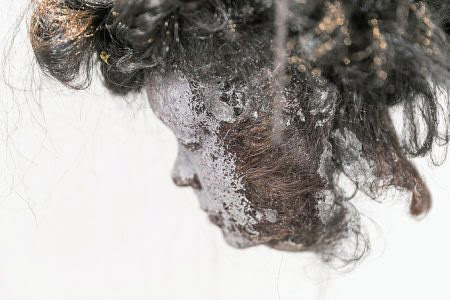
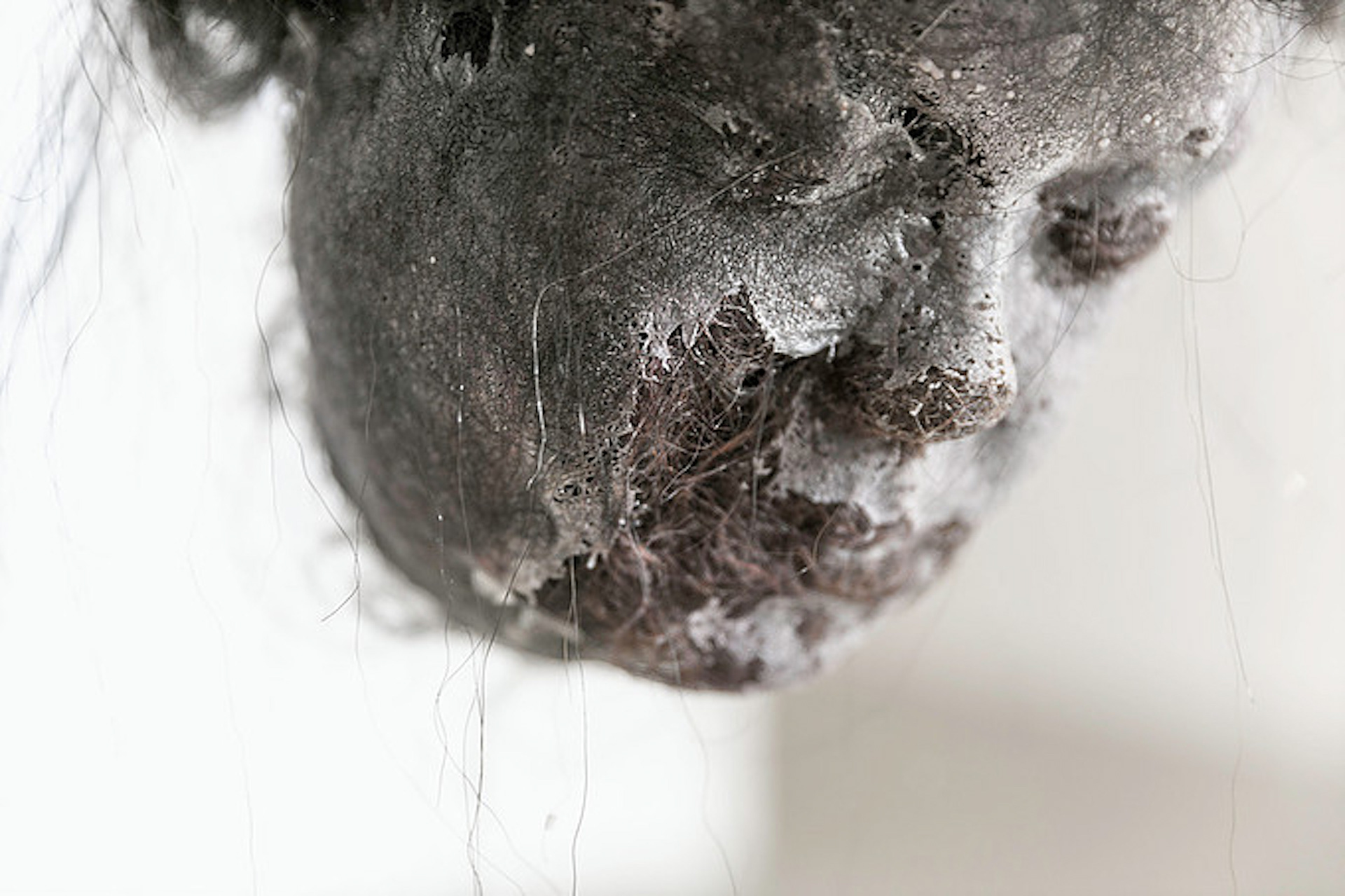
Burden, artist's hair (for the face), purchased human hair, synthetic hair (everywhere else), 2017
Kimberly Morris was born in West Los Angeles, California and grew up in Leimert Park, CA. Her rich Creole heritage has been a major influence on her work. Her great-aunt was Florestine Perrault Collins, a creole photographer based in New Orleans. Collins was one of 101 African-American women who identified themselves as photographers in the 1920 U.S. Census.
Kimberly critiques self-identity, ideas of beauty, popular culture, and race in America via video, sculpture, photography, and painting. She inserts herself into her work by casting her own body, using her hair, and portraiture—all forms struggling with the constraining expectations society imposes on women of color. She writes, “Through the lens of beauty, I examine my position in the diaspora. Pressures of fitting into what the majority culture defines as normal: neater hair and constrictive body typecasting, dictate my daily routine.”
Kimberly received both her BA and MA from California State University Northridge and her MFA from California State University Long Beach. Recent exhibitions include Residency at Cerritos College Art+ Tech culminating in the exhibition Laissez Les Bon Temps Rouler, Biomythography: Currency Exchange at Claremont Graduate University, Who Are You? at the Museum of Latin American Art. She was also awarded The College of the Arts Award from Cal State Long Beach 2015.
What is beauty, what is beautiful to the world I live in today?
Being a multi-ethnic individual of Creole heritage has played an enormous role in the way I view the world around me. I am of African and European descent; this greatly influences the way I experience society. Through the lens of beauty, I examine my position in the diaspora. The pressures of fitting into what majority culture defines as normal, neater hair and constrictive body type casting dictate my daily routine. Tangled in a mixture of black and white are the constant changes in trends and standards layered onto the historical weight of my skin. I am questioning the judgment that is placed on not only me but on those who navigate the world with this same burden. For the majority of black people, hair has become a racial identifier, which speaks for us before we have an opportunity to speak for ourselves. In thinking about my own hair and my existence within the diaspora I often reflect on how my culture influences my perspective. Mardi Gras is a tradition that dates back thousands of years in Europe but took place for the first time in New Orleans on March 3, 1699. By the time it made it to the shores of North America it had lost much of it pagan meaning but was now shrouded in a blanket of Catholicism. Masking is one of the most visible and significant traditions during Mardi Gras. Masks are worn to escape class, societal constraints, and being free to participate in social commentary while keeping one’s identity concealed. For many black people, our hair has become something that we feel forced to conceal or “tame” in order to navigate life. Many of us mask ourselves by wearing wigs, weaves, and go through painful damaging straightening processes to be more accepted and perceived as non threatening. In more recent years there has been a re-emergence in the natural hair movement. I have created a series of masks that reflects on my own struggle, past and present, being both proud and afraid to be who I am. As a people despite facing an insurmountable amount of struggle and trauma, we always find a way “To Let The Good Times Roll”.
Passe Blanc, Digital Photo, 20" x 40", 2019
The Interview
Catalyst: Can you explain what kind of art it is that you focus on, in laymen’s terms, or rather wide-reaching accessible terms? And how/why you chose this to focus on?
Kimberly Morris: I make work about race in both American culture and the larger global black diaspora. I use the lens of beauty to have this conversation; primarily focusing on where I find myself and my personal identity within the context of Eurocentric beauty ideals. Using my own self- identity though it comes from a personal space often overlaps with larger overreaching conflicts and situations other black women /people find themselves in. I have found that beauty standards and its warped perspective are one of the places that racial constructs lay and wait; it is a quiet manipulator with very loud results. Popular culture’s idea of what beauty is places constraints on all women of color, but for me, more specifically black women. These standers have been forced upon us, yes, the idea of personal style and choice plays a role, but the overreaching idea for far too long is that we have had to make decisions about our outward appearance for the purposes of survival in a Eurocentric world.
Catalyst: What do you think of California’s ban on discrimination based on a person’s natural hair, do you think it will help?
Kimberly Morris: I definitely think the bill is a push in the right direction for the freedom to simply exist, however, what stops a potential employer from not hiring you because you are wearing your natural hair? From my understanding, the legislation is designed to protect us once we have gotten the job, or are enrolled in these institutions. What happens when we arrive to interviews with our natural hair and are not considered because of it, how do we prove that’s what actually happened? From personal experience, I can tell you I have struggled with the decision to wear my hair in its natural state or to straighten it for an interview because I know depending on who is interviewing me my outward appearance will hold weight in their decision making depending on the biases the interviewer(s) hold. At this point in my life, I come with the perspective of taking me as I am, If my hair holds that much weight in your discussion making process then you don’t deserve me
Faith Without Works, Digital Photo, 20” x 40”, 2019
Creole Queen, Digital Photo, 32” x 40”, 2019
Catalyst: What kind of things do you think need to happen to make this situation better for everyone involved?
Kimberly Morris: Representation. Representation. Representation. I cannot say it enough, the representation of black people in popular culture is of the utmost importance for all parties involved. The more you see us and we see us in our full glory the more things will begin to change. This does not just mean in the media but in all spaces. The public has to become comfortable with our presence and our existence, which is not something that we have achieved yet in my opinion. The idea of a people being faced with the idea to “tame” themselves for those that subscribe to ideas of Eurocentrism is absolutely degrading.
Catalyst: What kind of roles do you see science making in helping to fix this problem?
Kimberly Morris: I believe that researchers, like Ami and her work, are highly important to the growing natural hair movement.Informing the public about the health risks that the chemicals we put on our skin and hair poses to us will continue to add to the growing numbers of black people that are leaving relaxers and other harmful products behind.Black people in science, researching things that harm black bodies as a whole and taking action to inform us is crucial for the survival of our people, as no one has a vested interest in our survival as people except us.
Catalyst: What kind of roles do you see art-making in helping to fix this problem?
Kimberly Morris: In the same way that I see Science playing a beneficial roll in our survival I view art in the same regard. Art creates a space for us to question our actions, the roles we play as individuals, and the roles we play in groups. Art is reflective of humanity’s current situation and or plight regardless if all members of society want to admit to our truths or not. Just as one cannot hide from the laws and facts of science, you cannot hide from the truths that are told at the hands of creators.
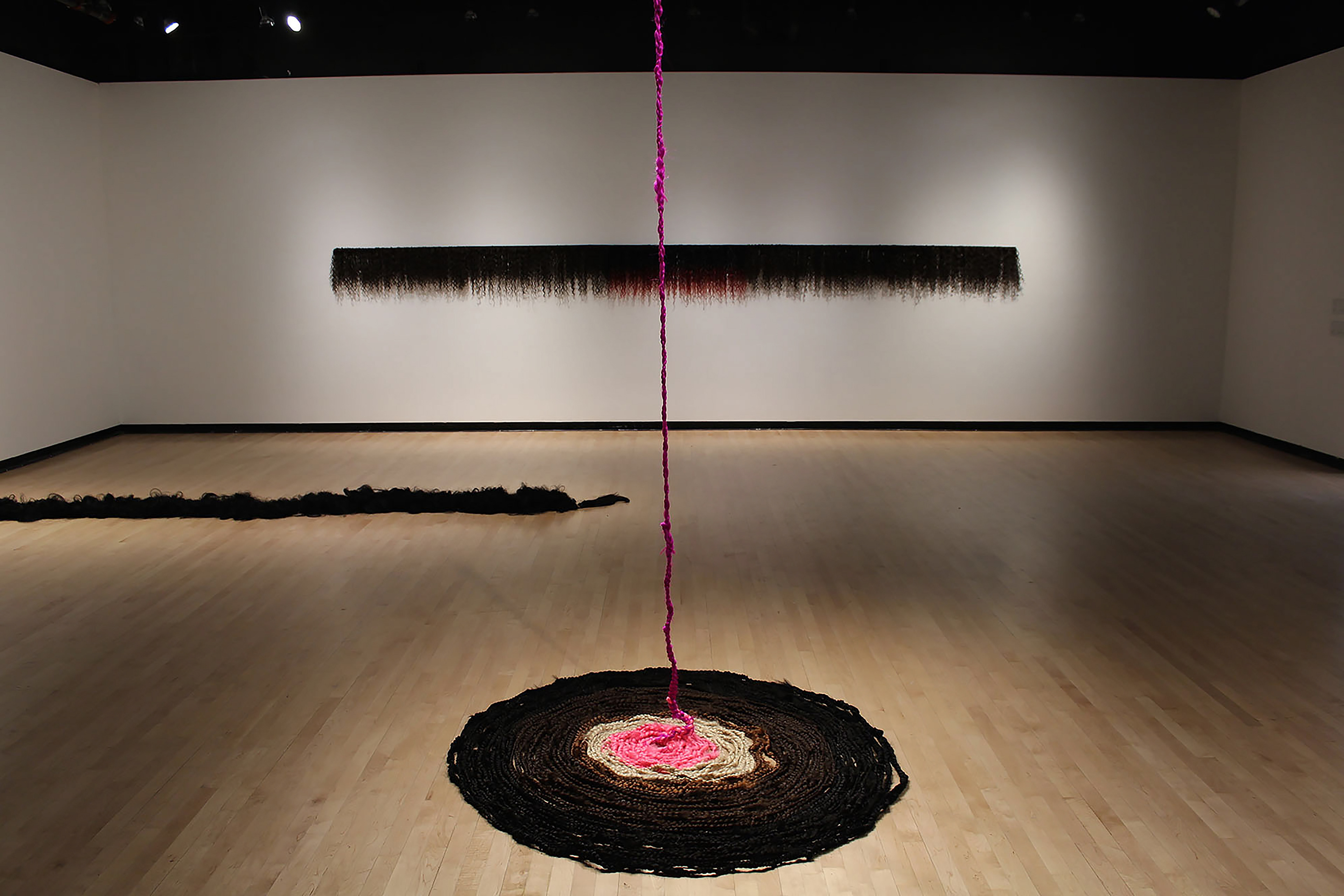
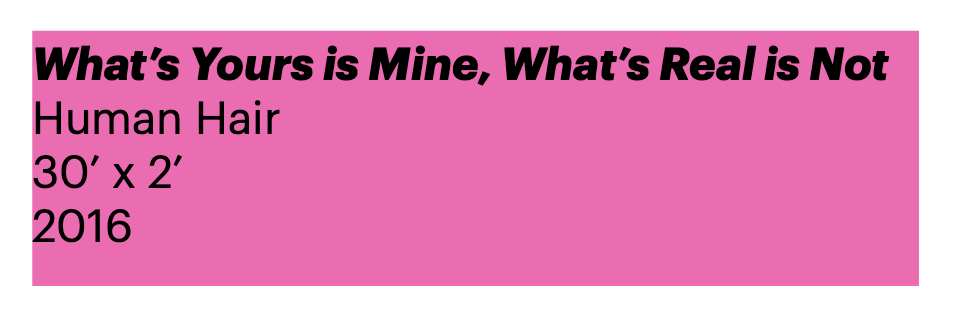
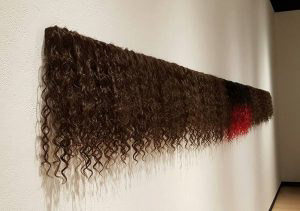
What's YOurs in Mine, What's Real is Not, Human Hair, 30' x 2', 2016
Catalyst: What do you think about Ami’s work in relation to your work? Can you explain how this research resonates with you, as something you’ve experienced your whole life? And what kinds of things can be done to make it better?
Kimberly Morris: In relation to my work, Ami’s research absolutely resonates with me and will be something I refer to when I am working. I was aware of some of the harm that these chemicals cause, however, I realized after reading her findings that I only had a surface understanding of what was happening. I had no idea the extent of the biological damage these chemicals cause. As an artist that makes work using hair as the bulk of my medium, it excited me to read her findings. As a black woman, it horrified me.
These ideas centered around hair have been something that I have experienced my whole life. I had a love-hate relationship with my hair for the bulk of my childhood and into early adulthood. I can remember, as a child feeling like my hair was a problem. I recall learning to straighten my hair with a hot comb and being beyond frustrated that I couldn’t get it straight enough, memories of my mother attempting to use home perms to loosen my curl but too afraid to leave it on long enough as she had fear of the damage it would cause to my hair. As an adult, I recognize that my fits of frustration I was having while actively trying to style my hair was actually mild anxiety attacks. I recall feeling waves of heat come over my body, prickly needles all over my skin, tears running down my face, and for what? Because I couldn’t get my hair slick enough, to make other people comfortable about my existence?
I have made many changes on how I care for my hair now, I don’t use relaxers, I try and use paraben-free products, and have reduced how often I apply heat to my hair, I have even stopped dying my hair which is a whole other conversation in relation to women aging publicly. Do I sometimes want to straighten my hair for style, sure, but it’s never for the acceptance of others anymore.
Catalyst: What kind of products have you used and why? Have you used different products on yourself vs. your artwork, because of hair types? Can you talk about the residency you did at Cerritos and the experience you had with the cosmetology department, like chemical usage, like how you weren’t allowed to touch them for safety reasons? Did they use products/chemicals you had already used in the past?
Kimberly Morris: I currently am using paraben-free conditioners and shampoos (brands vary), in addition to natural oils like argan, coconut, and Jamaican Black Castor oil.
In regards to my work, I do use different products on myself vs. my art. Sometimes it’s because of hair type, sometimes its because I’m bleaching and dying the hair a new color. Also, I am making sculpture so I need to make sure the work holds up for the long term.
I was honored to have been selected to participate in the Art + Tech Residency at Cerritos College, it was an experience of a lifetime and couldn’t have asked for a better opportunity.
I got a crash course on how to do certain things like dying and bleaching, for example, however, I was not allowed to actually apply those techniques while present in the cosmetology department as the state board would not allow it, because of the use of toxic and potentially harmful chemicals without a license. Though many of the products I was using, I had used it before on my own. So with that being said, I was fortunate enough to have two students aid me in executing desired colors that I wanted.
Catalyst: How much of a conversation is the environmental impact when making beauty product choices, what kind of factors go into the decision to use or not use a product?
Kimberly Morris: Honestly, I don’t think the environment has ever been put into consideration when selecting beauty products other than avoiding products that come in aerosol cans. It’s actually never crossed my mind that the products I use could be harmful to the environment around me. Since I have changed up the products I use over the year, I take into account how harmful products may be to my person before purchasing. I would assume if they are harmful to my body they are probably harmful to the environment.
Thank you to everyone who took the time to read this post. I hope you will check back for future posts. Some other links you may want to check out:



